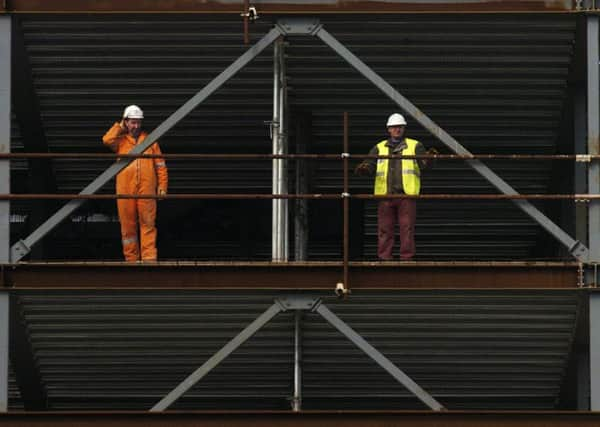Scots economy enjoys healthy period of growth


The eleventh consecutive quarter of expansion at the start of 2015 and “upbeat” forecasts for the future have been tempered slightly by warnings of continuing internal and external challenges.
The economy may not be keeping pace with consumer spending with savings declining, and there are signs of an impending interest rate rise, Chief Economist Gary Gillespie said.
Advertisement
Hide AdAdvertisement
Hide AdAll main sectors of the economy grew, with a particularly strong performance in construction, but this was driven wholly by public sector building.
The continuous growth “demonstrates the Scottish economy’s underlying resilience given the difficult external and domestic challenges that we have seen”, Mr Gillespie said.
But he added that the growth in public building was unlikely to continue indefinitely as major public projects such as the Forth Replacement Crossing, two hospitals in Glasgow, Borders Railway and new schools were either finished or nearing completion.
Meanwhile, private building had contracted with a decline in industrial and commercial building, such as new shops and warehouses, only partly offset by a growth in housebuilding.
Housebuilding had been driven by rising house prices and increasing consumer confidence caused by rising wages and more full-time jobs, although full-time hours remained below pre-recession levels.
Mr Gillespie said: “With oil prices remaining well below last year’s levels in recent months, the impact of low oil prices will continue to have a material bearing on economic conditions in Scotland, with both positive and negative implications.”
The low oil price has kept business and consumer costs and prices low, thereby subduing inflation, but it has had a knock-on effect for Scotland’s oil industry.
Mr Gillespie added: “The very low inflation in advanced economies that has prevailed since oil prices fell at the end of last year is showing signs of bottoming out.
Advertisement
Hide AdAdvertisement
Hide Ad“Forecasters expect inflation to start rising again towards the end of this year as economic conditions continue to improve and last year’s oil price effect drops out of the annual inflation calculation.
“With this in mind, discussions among central banks have refocused on the appropriate time to begin normalising monetary policy and increase interest rates.
“Based on the economic outlook and signals emerging from central banks, markets are now expecting the first US rate rise before the end of this year and the UK to follow in the first half of 2016.”
Forecasts point to a positive outlook for Scotland’s economy for the rest of this year with growth of around 2.4 per cent in 2015.
Deputy First Minister John Swinney said: “Our programme of investment in public infrastructure is paying off, helping support a particularly strong performance in the construction sector.
“The benefits from this investment will underpin future growth in the Scottish economy and is the appropriate response in order to support and grow the economy rather than the UK Government programme of austerity.
“Although Scotland has not been immune to the global economic challenges over the last few years and there is undoubtedly still work to be done, these figures show our economy’s underlying resilience - with positive trends apparent in both employment and investment levels.”